Table of contents
- Suzuki patent for 650 cc parallel twin Turbo-Twin for the SV 650 and V-Strom 650?
- Suzuki continues to work on the turbo
- SV successor with parallel twin
- Two balance shafts
- 90 ° twin
- Motor contributes
- Clever oil circuit
- New V-Strom is also likely
- Conclusion
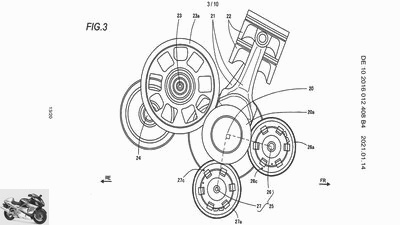
Suzuki

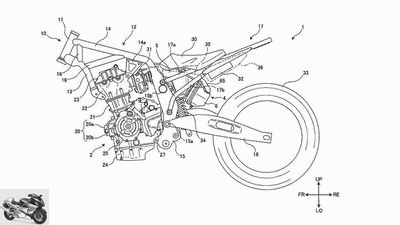


19th pictures
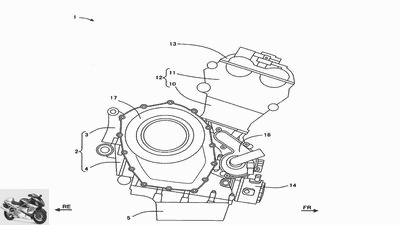
Suzuki
1/19
This is what the XE7 engine looked like as a 2013 and 2015 design study. The basic architecture of the turbo system has been expanded in the current patents to include water cooling for the turbo.

Suzuki
2/19
The cooling circuit of the entire engine is pressurized by just one water pump. Turbo, oil cooler and the actual cooler for the water are initially kept separate by means of a simple but clever system and then connected at the end in front of the hot turbo.

Suzuki
3/19
Apart from the puny tubular frame: The Suzuki system is very compact, the height and depth of the engine do not differ significantly from naturally aspirated engines of the same displacement.

Suzuki
4/19
Due to the water cooling of the turbo, it can be mounted very close to the outlets without causing heat to build up there. At the same time, the short path of the hot exhaust gas increases the efficiency of the charger and ensures a short response time.

Suzuki
5/19
The coolers for water (above) and oil (below), which are mounted one above the other, can be mounted very close to the engine, as the oil cooler is also cooled by the water. Unique construction.

Suzuki
6/19
Advantage: The oil cooler could be designed more as a heat exchanger, as it no longer needs the vulnerable cooling fin construction and is less sensitive to mechanical influences such as stone chips. The reliability of this extensive system would be increased.
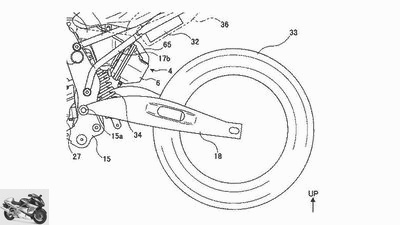
Suzuki
7/19
The drive of the balance shafts directly from the crank allows the housing to be built narrower.

Suzuki
8/19
The patent drawing could be a preview of the new Suzuki SV 650.
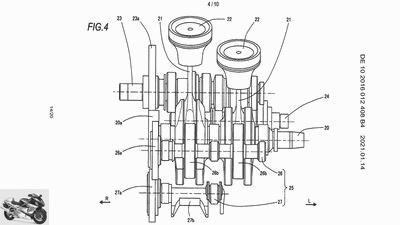
Suzuki
9/19
The 700 cm³ parallel twin could serve as a compact successor to the 650 cm³ V2.

Suzuki
10/19
Inlet and airbox of the new 700 cm³ parallel twin. This could of course also be used to modernize a mid-range V-Strom.

Suzuki
11/19
Space-saving and compact: the airbox and the filter can be installed directly above the motor.

Suzuki
12/19
Further patent drawings show a possible frame variant that integrates the two-cylinder in a load-bearing manner.

Suzuki
13/19
The rear suspension relies on a lever for the central spring strut.
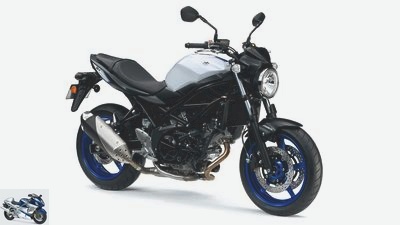
Suzuki.
14/19
However, the current SV 650 is likely to receive a Euro 5 update, which extends its service life indefinitely.
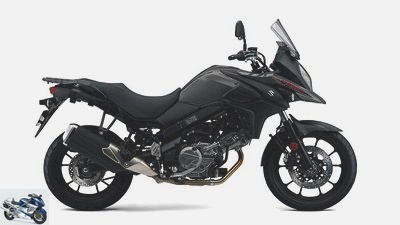
Suzuki
15/19
And the V-Strom 650 also has to wait a few years for the motor update. Of course, an increase in displacement to around 700 cm³ is also conceivable.

Suzuki
16/19
New drawings show that Suzuki is probably planning to build the twin with two balance shafts …

Suzuki
17/19
… which indicates the use of a crank pin offset of 90 degrees. The now common design for modern row wins.

Suzuki
18/19
The drawing shows: The engine will definitely be supporting.

Suzuki
19/19
The position of the balancer shafts in front of us under the crankshaft enables the transmission input shaft and clutch to be positioned high and thus space-saving.
counselor
technology & future
Suzuki patent for 650 cc parallel twin with turbo
Suzuki patent for 650 cc parallel twin
Turbo-Twin for the SV 650 and V-Strom 650?
Suzuki is working on a new mid-range engine and is very advanced. Patent pictures suggest crank pin misalignment, mass balancing and frame construction. A water-cooled turbo is also being planned.
Dina Dervisevic,
Uli Baumann,
Jens Kratschmar
06/11/2021
Suzuki has been developing turbo engines for several years. The turbo twin project debuted in the concept bike in 2013 “Recursion”, which was shown with a 588 cc SOHC twin, which two years later blossomed into a 700 in DOHC design. The XE7 engine was presented at the Tokyo Motor Show. Since then, while a steady stream of patents has indicated that the project is nearing production, there have been indications that a free-aspirating version of the engine is also in the works. And the turbo project in parallel twin is evidently being driven forward with a water-cooled turbine and an elaborate cooling circuit.
Suzuki continues to work on the turbo
It had become a little quieter around the Suzuki turbo twin. Especially after the last patents for the vacuum cleaner, nobody in the editorial office believed in the turbo anymore. O-Ton colleague Baumann: “I don’t believe in the engine anymore.” But you, dear Ulrich, have been shown by the latest patent: Suzuki is still working on the turbo for the twin. And they have obviously been very concerned with engine heat management. The actually good plan to place the turbo very close to the outlet is unfortunately associated with a large amount of heat build-up behind the water cooler in motorcycle engines. Suzuki is therefore not only planning to use water to cool the turbo itself, but also the indispensable oil cooler. In this case, this could be done using a heat exchanger, which can then be made much more flexible in terms of its structural dimensions than a conventional cooler with fins. The entire unit for the supercharging seems to be very real and almost ready for production: The system for guiding the air from the air filter over the compressor side of the turbo back into the airbox is very compact, which allows a small structural dimension and the drive is not significantly larger appears as a naturally aspirated engine. However, this does not allow any conclusions to be drawn about the possible boost pressures, as the intercooler built into the airbox is rather small. 130 hp from 700 cubic should be in there.
SV successor with parallel twin
There are more details about the inner workings via a naturally aspirated engine, which is derived from the said turbo engine, and also via a new motorcycle that could inherit the Suzuki SV 650. The patent document shows images of the fuel tank, seat and subframe and allows a detailed view of the tubular steel subframe that integrates the engine as a load-bearing component. The trellis construction allows a lot of design options or quick changes to the geometry of different models on the same basis.
Two balance shafts
The patents also show a technical solution for driving the required balance shafts. Two in number. They should be driven – that is the actual invention – directly from the crankshaft on the side of the primary drive. The design – not unlike the current F-motor from BMW – saves a lot of installation space, which makes the crankcase more compact. The position of the two balance shafts in front of and under the crankshaft in the direction of travel also do not impose any additional size on the gearbox. The lower balancer shaft is integrated in the housing in such a way that, depending on the engine configuration, it can simply be omitted without further design measures. In other words, a 180-degree twin can also be implemented.
90 ° twin
In addition, the new drawings reveal that Suzuki is currently planning the Twin with a crank pin offset of 90 degrees, which requires two balance shafts for better concentricity in the lower speed range. The new Suzuki twin would be comparable to the twins from Yamaha, Kawasaki, Triumph, BMW and many others in terms of power delivery, sound and characteristics.
Motor contributes
As can also be seen in the pictures, Suzuki plans to carry the twin in the middle, probably using a tubular steel subframe, combined with a sturdy aluminum construction for the engine. and swing arm bearings. The patent underlines this approach, as Suzuki uses a side stand attached to the engine in relation to the lower balancer shaft.
Clever oil circuit
In the patent, Suzuki mentions the oil cycle with many references. The most interesting thing: The lower balance shaft and the oil sump are designed in such a way that the shaft does not splash the oil in any operating condition and so no air can get into the lubrication. This is supported by the idea of directing the air pressure caused by the piston moving towards BDC towards the sump in such a way that it permanently causes small waves on the surface of the oil, which further suppresses the formation of air bubbles. The drive of the balance shafts on the right in the direction of travel should also prevent the splashing in the oil while running on the side stand. This solution also benefits the sensitive oil circuit of a turbo engine, whose constant supply of cool lubricant is essential.
New V-Strom is also likely
Although the motorcycle shown in the drawing most likely indicates a new SV 650, the new parallel twin could also provide for a modernization of the adventure bike V-Strom 650. A Suzuki SV 700 and a Suzuki V-Strom 700 are of course also conceivable. However, we still have to be patient for this: In the 2021 model year, Suzuki first launched a slightly modified SV 650 that meets the Euro 5 standard and extends its service life indefinitely. The new Suzuki parallel twin – with and without turbocharging – is likely to be a project that will only go into production in the next few years.
Conclusion
Suzuki is working on a new engine for its mid-range models. The V2 installed so far is strong and reliable, but not cheap to manufacture. The successor will probably compete as an inline two-cylinder, possibly with a turbo. Reihentwins has known the competition for a long time, the turbo in the middle class would be unique.
Related articles
-
Yamaha patent for three-cylinder turbo
Yamaha Europe 5 pictures Yamaha Europe 1/5 Yamaha MT-Turbo? Visually, the experimental engine seems to be planted in the chassis of an MT; the thick…
-
Suzuki electric scooter patent: electric and air-cooled
Suzuki Motorcycles 4th pictures Suzuki Motorcycles 1/4 This is what the Suzuki electric scooter could look like. Drive probably via chain or belt,…
-
Suzuki patent Radically changed engine mounting position
Suzuki motorcycles Suzuki patent Radically changed engine mounting position Suzuki patent Radically changed engine mounting position A motorcycle engine…
-
Suzuki patent: Variable valve control 2.0
Suzuki 8th pictures Suzuki 1/8 Suzuki is working on a new variable valve control. Suzuki 2/8 It should serve the inlet and outlet and be hydraulically…
-
Patent semi-automatic transmission for Suzuki Hayabusa
Suzuki 6th pictures Suzuki 1/6 Suzuki has patented a semi-automatic transmission. Suzuki 2/6 The patent relies on a conventional transmission with a…
-
Honda compressor patent: series twin with supercharging
Honda 5 pictures Honda 1/5 Honda has combined the Africa Twin’s in-line twin with a supercharger in a patent specification. Honda 2/5 The twin screw…
-
Patent for Harley-Davidson with compressor
Harley-Davidson 9 pictures Harley-Davidson 1/9 Harley would build a compressor behind the engine on top of the gearbox. Harley-Davidson 2/9 The drive is…
-
Driving report Suzuki SV 1000 S
motorcycles Driving report Suzuki SV 1000 S Driving report Suzuki SV 1000 S Once again Again Suzuki wants to start flying high with a V2. After SV 650…
-
motorcycles Review Suzuki SV 650 S Review Suzuki SV 650 S Blind date Positioning. The Suzuki SV 650 S meets the Honda CB 500 S, the Yamaha YZF 600 R, the…
-
Second-hand advice: Suzuki GSX 1400
Suzuki counselor Used purchase Second-hand advice: Suzuki GSX 1400 Service: used advice, Suzuki GSX 1400 Suzuki GSX 1400 “We can do it differently!”,…